Lenovo Yoga 3 Pro Review: Refreshed With Faster Core M
by Brett Howse on March 13, 2015 8:00 AM ESTDesign and Chassis
The Yoga 3 Pro’s design is certainly striking, especially in the Clementine Orange version which was shipped to us for review. It is incredibly thin, coming in at just 12.8 mm, or 0.5 inches. It is very light as well, with the Yoga 3 Pro tipping the scales at 1.19 kg, or 2.62 lbs. The most striking feature of all is the watchband hinge, which consists of 885 pieces of aluminum and steel. It is functional too, with the new hinge allowing the Yoga 3 Pro to be opened 180° and sit completely flat, as well as continue to open all the way to 360° to use the Yoga 3 Pro as a tablet. The hinge has a good amount of stiffness in the travel, and stays exactly where you open it to. The hinge also has six focus points, as compared to just two on the outgoing model.
The exterior of the Yoga 3 Pro is in colored plastic, with three colors available for purchase. The orange on the review unit has an almost metallic paint job to it, with some subtle sparkles in the coating. The exterior is clean and simple, with the only notable features being the chrome Lenovo text on the top, the watchband hinge at the back, and a couple of speaker grilles on the bottom.
Once opened up, you get a glimpse of the 13.3 inch display, which is covered in Corning Gorilla Glass. When in one of the touch modes, this will be your primary interface for the device, and where as the Dell XPS 13 has removed the display bezels, the Yoga 3 Pro keeps them. For a touch device, this seems to work better, especially when trying to initiate one of Windows 8’s edge gestures. With the tiny bezel on the XPS 13 this could be slightly more difficult, but on the Yoga 3 Pro, there was no trouble there at all. The one issue found with the touch interface is that the Start button on the display seemed miss some of the attempts to invoke it. Lenovo has let me know that they are working on a fix for the sensitivity of the Windows button on the display.
The left side of the device features a SD card slot, mini HDMI port, and a USB 3.0 port. The power port is also on the left side, and Lenovo has created a new form factor for the port, which allows it to double as a USB 2.0 port as well when the power cord is not plugged in. It is a nice bonus, when most Ultrabooks only come with two USB ports. The right side features another USB 3.0 port with Sleep Charging, headset jack, volume rocker, display lock, Novo (Recovery) button, and a new location for the power button. Lenovo found that the placement of the power button on the Yoga 2 Pro could cause people to accidently push it, so they have moved it into the middle of the device to correct this.
The keyboard deck has been updated as well, and is now covered in a soft, dimpled coating, which makes the device quite comfortable to type on, as well as gives it a sturdy base for Stand mode. The backlit keyboard is also slightly different, with Lenovo going from six rows of keys, to just five. The sixth row on the Yoga 2 Pro was the function keys, as well as various Fn functions such as display brightness, volume, and others.
While the core typing experience is very much the same as the outgoing model, the removal of some of the keys has compressed a lot of the functions onto other keys. The volume up and down is now Fn + Left/Right, and brightness is Fn + up/down. I appreciated the dedicated Home and End keys on the Yoga 2 Pro, but they are now doubled with the Page Up/Down keys. When looking at the deck of the Yoga 3 Pro, there is quite a gap between the top of the keyboard, and the top of the deck, which I can only assume Lenovo has done to improve the ergonomics when holding the device like a tablet. The keys are very much centered now, so holding the top or bottom of the device means you only feel the soft dimpled texture of the keyboard deck.
The trackpad is also very much the same as the Yoga 2 Pro, with a Synaptics clickpad being made available. It is quite smooth, and easy to use. I did find the two-finger scrolling to be a bit odd in modern Windows. The Start Screen, for instance, would not scroll with two-finger scrolling, but the selected tile would change. It is different behaviour, which is the only reason I mention it. The Synaptics software does have quite a few more options than the Microsoft Precision Touchpad drivers, which anyone who likes three and four finger gestures will appreciate.
One cannot discuss the design of the Yoga family without discussing the convertible nature of the device. The Yoga 3 Pro can be switched into four modes by simply folding the display into different orientations. The normal mode is laptop mode of course, and here the Yoga 3 Pro performs very well, and unlike convertibles with detachable displays, keeps the traditional balance of a laptop with the processor and battery in the keyboard section.
Next up is Tablet mode. The Yoga 3 Pro is generally too big for use as a tablet, but it does work in this orientation. They slightly smaller keyboard is appreciated for this model year, since you are less likely to be holding the device where the keys are. The keyboard is of course deactivated in this mode, so it is only a comfort issue.
Tent mode has the laptop folded like an inverted V. The footprint of the device is incredibly small in this mode, and it is very sturdy as well. With the back of the laptop acting as a kickstand, touch inputs on the screen are free of bounce from the display pushing against the hinge. If you have somewhere sturdy to set the Yoga 3 Pro, and you need to use it like a tablet, this is the mode to use.
The final mode is the one that I tend to use more than the others (except laptop mode of course). Stand Mode is fantastic for any sort of media consumption, and in this mode I find the Yoga 3 Pro easily outperforms most tablets. The display holds itself up, unlike a tablet, and with the keyboard underneath as a base it is very sturdy on uneven surfaces, such as watching a movie in bed.
On a recent trip to Anaheim, I brought the Yoga 3 Pro to see how it would perform on an airplane. The Tent Mode and Stand Mode were excellent for watching movies, or playing games. The smaller footprint made it easy to use on a tiny airplane tray, and with the display at the front, reclining seat backs were never an issue. For those that travel a lot, this would be a good device to consider.
The Yoga 3 Pro keeps the tradition of the Yoga’s design intact, but refines it further. The new model is thinner, and lighter, and features a very nice looking, yet functional, watchband hinge. The new keyboard deck material is quite nice to use, and the smaller keyboard makes the Yoga 3 Pro a bit better to use as a tablet. Overall the design is a nice iteration of an already solid concept.



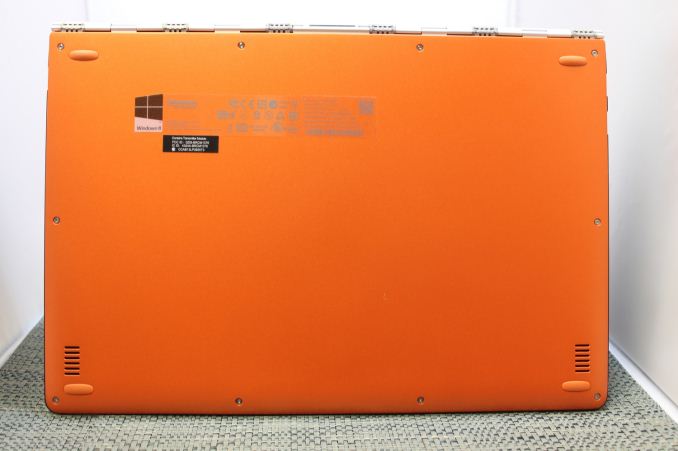


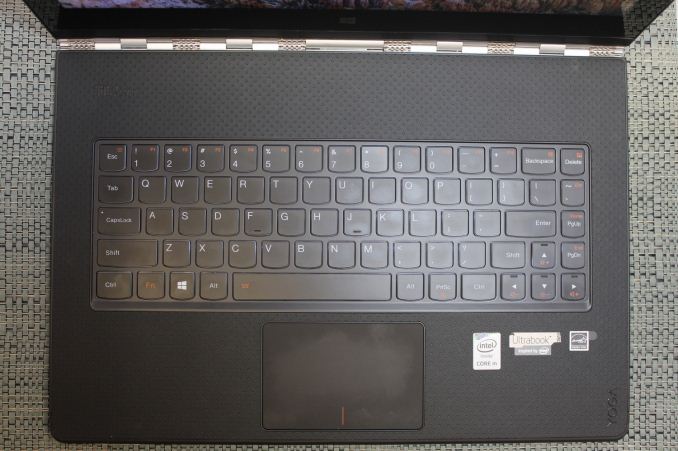
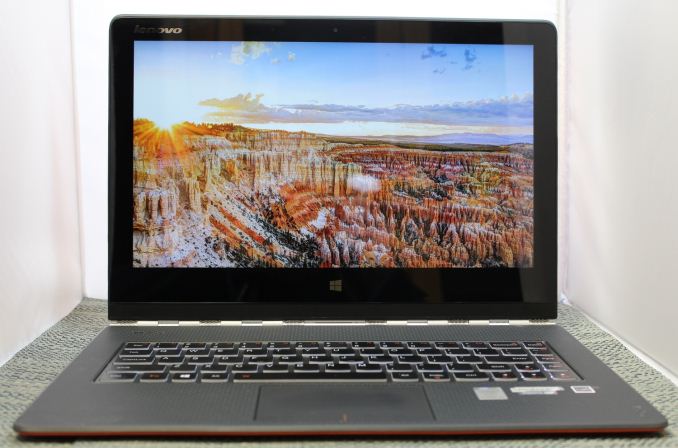

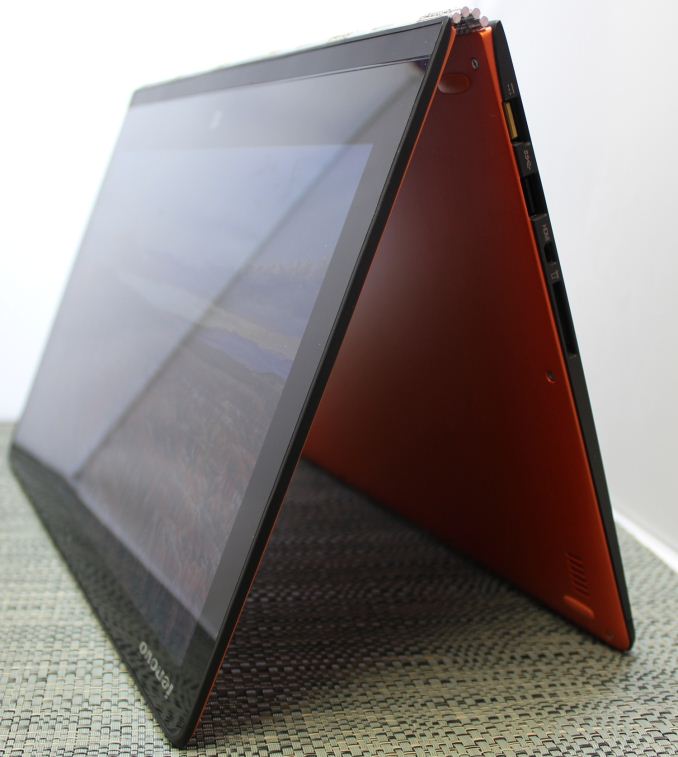
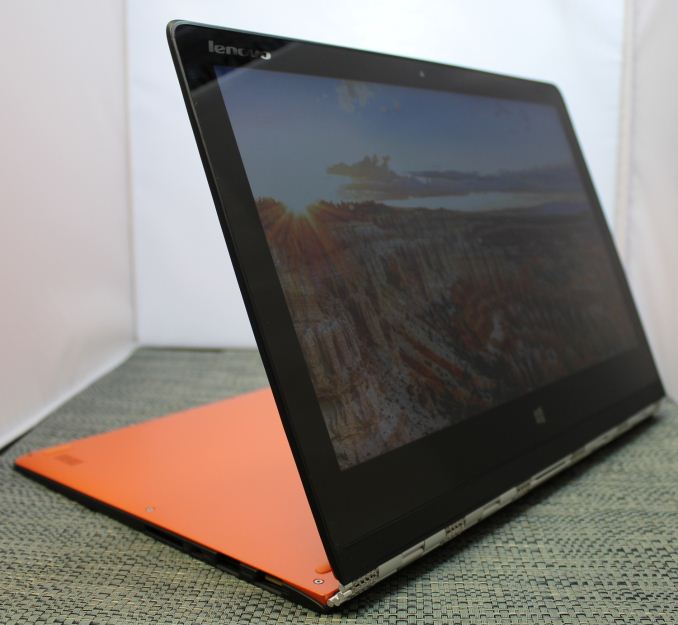








113 Comments
View All Comments
coolhardware - Friday, March 13, 2015 - link
I'm hoping Lenovo follows in Dell's footsteps and gets rid of the bezel around the screen along with big wasted area around the keyboard.Pretty sweet to get the same display size and pixel density:
13.3″ 75.59 square inche display (11.6″x6.5″) 3200×1800 16:9 Ratio 276.05 PPI
***all in a much smaller form factor!***
*Source for display specs: http://pixensity.com/list/laptop/
fokka - Friday, March 13, 2015 - link
the thing is for the tablet mode it's nice to have some bezel to grip the whole thing, so going the minimal bezel route like the xps 13 wouldn't be the most comfortable thing on a device like a yoga 3 pro.that's the same reason we have the big wasted space around the keyboard: that's where you hold the device in tablet mode. i think they still should have given us at least a row of half-height function keys, but we see that a convertible is always a compromise.
fokka - Friday, March 13, 2015 - link
agreed. the hinge might look nice to some and as long as it works it's fine by me, but if they go ahead and bost about it consists of over 800 parts, that just screams "over engineered" to me.i also don't see how a simple hinge has to look like a watchband, or a piece of jewelry and again: using 800 parts, when you could reach the same goal with just two is simply too much in my book.
Cook-e-Monster - Friday, March 13, 2015 - link
Hugely disappointing to see the keyboard get compromised like this. one of the most useful things about Lenovo is that they make good keyboards with intelligent layouts. Nixing the F-row and hamstringing the PgUp/Down and Home/End keys is probably a deal breaker for me.I really hope that there's a review coming for the recent HP Spectre. I think it (and the XPS) has Lenovo beat this year
Sushisamurai - Friday, March 13, 2015 - link
I appreciate you linking the notebook bench link, but the Lenovo Yoga 3 Pro isn't listed on your bench results yet (nor in CPU bench). I was also hoping there would be more of an in-depth discussion about the Core-M CPU and probably a few more "real life" use case results and short comings of the CPU, as this is Anandtech's first product review with a Core-M.I like how you included Dell's XPS 15, but for those unfamiliar with that model, I think you should have at least mentioned what CPU it was other than being a quad-core CPU. Without bench results, it's also hard to compare what core-M's performance is compared to other broadwell/Haswell offerings as the charts are comparing tablets and some Haswell-U's. I think it'd be an interesting dive to see what users would be sacrificing in terms of performance to go to Core-M (form-factor) versus intel's bigger mobile processors. I suppose I could wait for the bench results and pore over the charts myself, and since anyone can do that, that's not why we read anandtech.
Brett Howse - Saturday, March 14, 2015 - link
Sorry the Yoga 3 Pro was in Bench but not enabled for public viewing until after I posted. I just enabled it now.I did mention in the article that the Dell is a quad-core part. I have some more ideas as well to make that more clear but it's a backend thing.
Look for more Core M discussion soon. We had issues getting samples at the start since it seemed like a really slow release but we have some now. I've got a couple more Core M devices in my queue to look at.
Sushisamurai - Sunday, March 15, 2015 - link
Sweet. I'm looking forward to more core-M reviews. I think a lot of our readers are interested in reading what you guys have to say about the new MB apple released.Also, I'm aware other products' performance is listed in bench but it would be nice to include products that match the one you're reviewing in terms of size, form factor, and price - I felt that the products you included in your charts were heavily skewed to tablet comparisons, where we could have used some more comparisons for products in similar price ranges.
Otherwise, good read, thank you for your hard work.
sandineyes - Friday, March 13, 2015 - link
I actually bought a Yoga 3 Pro (my first laptop in over 10 years) during the holiday season, and eventually returned it after a few weeks. My thoughts:-The build quality on this thing is pretty poor for such an expensive device. The panel on the back of the screen on mine flexed quite a bit, as if it didn't fit perfectly. Similarly, there is a piece of plastic below the display that looks like it is fit into a rectangular slot, and that wiggled around too, as if it was glued poorly or something. It also shows usage very poorly; no amount of hand washing prevented it from looking like a mess after using it. I had a chance to touch a MBP while I owned this, and that felt markedly better made.
-The screen is not very good. It wasn't really that much of a problem, and the article mentions it getting better in the refresh, but mine was pretty poor. It was also my introduction to HiDPI Windows and all the caveats that come with that. I am also used to my 16:10 desktop monitor, so I'm probably a bit biased. But seriously, we need more 16:10 laptop screens that aren't on Macs.
-It generally felt fast enough, but mine could not handle HD streaming on Amazon Instant Video (tried Chrome and latest IE). The video would start stuttering, making it un-watchable. Netflix didn't have this issue, and neither did a 1080p video stored locally when used with VLC. I don't know if the refresh has this issue, but it made Amazon Instant Video a last resort.
-The battery life is terrible. I am not really used to laptops, so for me the 5 hours of life I managed out of the thing felt very oppressive. And although this is a minor issue, the included charging cable is too short.
-The last laptop I owned had physical click buttons; my index finger worked the pad, and my thumb rested on the left click button. Based on the Yoga I cannot see how people have adapted to use these new-fangled track pads with no buttons. It is like we've actually regressed in technology over the last 10 years when it comes to this. Getting click and drag to work on these damn things is real challenge.
-Make sure you keep that Harmony software installed; otherwise the computer won't properly deactivate the keyboard and track pad when in stand mode.
-This computer makes me want more, better hybrids to exist. Because of the utility of stand mode, I do not think I can ever buy a normal laptop or a tablet. The light weight of this thing is also a plus, but I think that is more a benefit to tablet mode, which isn't that useful in comparison to the other modes.
fokka - Friday, March 13, 2015 - link
thanks for your quick review, it's interesting to hear some real life caveats, even if you didn't use the latest model.i also share some of the same complaints about at least some of the current ultrabooks. i recently got to test an asus zenbook (ux301la) and while it looked stunning with its white glass finish, it only stood on three of its rubber feet and kept wiggling, as you moved your hand to and from the palm rest. even the (buttonless!) glass touchpad made a slight squeaking sound, when you moused around on it.
it seems to me that many manufacturers have a problem converting those nice press renders and incredibly high specs into really usable products that don't show some serious flaws after a short amount of time.
many people say this machine (e.g. a zenbook), or that laptop (e.g. the new xps 13) offer incredible build quality, but still i have to see one laptop model to offer such a continuously high build quality as apple does with their whole macbook line. a shame, since i'm really not a fan of osx.
i'm also not the biggest fan of hi dpi screens, especially when the effect is made obsolete due to the use of a pentile matrix. it seems we're just wasting money, energy and gpu cycles, hell, even usability (->scaling), just to have one more spec to boast about. and all this on the machines that are conceptually the worst place to start the dpi-revolution: battery and performance limited mobile devices.
"The screen is not very good." ...if people sum up a screen with those (your) words, i think we can agree that this specific panel was a poor choice on a somewhat premium device like the yoga 3 pro.
and a new $$$$ laptop not managing 1080p playback on one of the biggest VoD services... i think i have seen enough of core m for one day, even if that specific problem turns out to be driver related.
kyuu - Saturday, March 14, 2015 - link
Considering that you can go to the HP website right now and get the Spectre x360 with 1080p touch, 8GB of RAM, a 256GB SSD, a Core-i5 5200U, a much larger battery and what looks like much better build quality all for under $1000, I'm afraid Lenovo needs to do more than this refresh to keep the Yoga line competitive. You can even upgrade to a QHD display for only another $100, if you prefer resolution to battery life. Hopefully you guys get in a Spectre x360 for review in the near future.And if you don't care about a 360-degree hinge and a touchscreen, then the Dell XPS 13 knocks it out of the park.